Structural Controls on Gold Mineralization in Zimbabwe
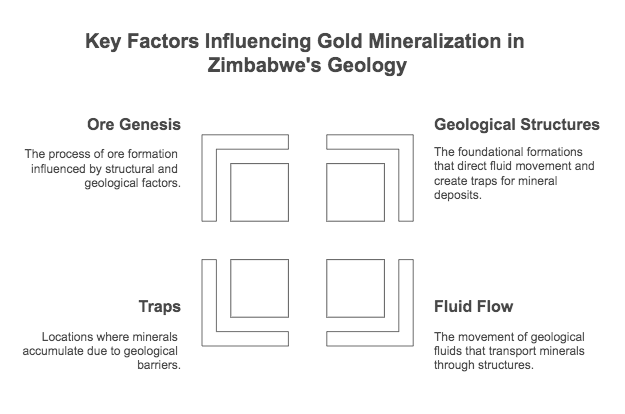
Geological structures are the backbone of gold mineralization in Zimbabwe. They guide fluid flow, create traps, and determine where high-grade deposits form. Recent studies confirm that multiple interacting structures are key to ore genesis, while alternate views stress the role of lithology. Below is a comprehensive breakdown.
1. Shear Zones
- Primary Conduits for Fluids:
- Shear zones are widely recognized as the dominant structural feature for gold deposits.
- They serve as channels for hydrothermal fluids, concentrating gold along well-developed shear planes.
- Types and Characteristics:
- Ductile Shear Zones:
- Exhibit a mix of brittle and ductile deformation.
- Often host significant, continuous high-grade ore bodies.
- Linear Shear Zones:
- Provide elongated, consistent pathways that facilitate fluid movement.
- Reverse-Dominated Shear Zones:
- Form under compressional regimes, enhancing fluid pressurization and gold precipitation.
- Alternate Perspectives:
- While some studies emphasize shear zones, others argue that mineralization also depends on the interplay with surrounding lithologies. Nevertheless, the spatial association of gold with shear zones is a recurring theme.
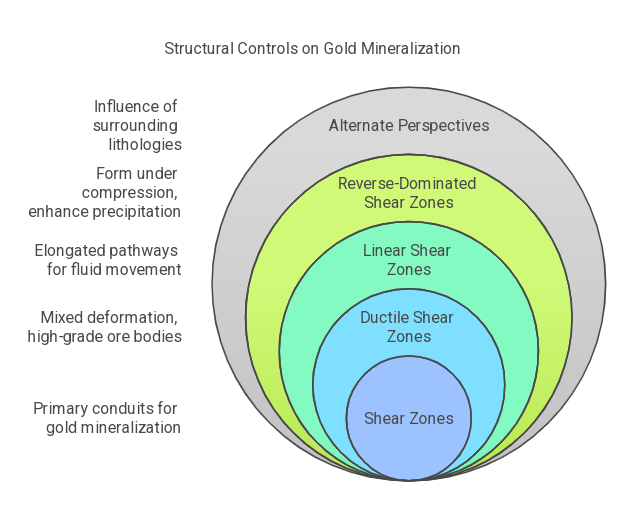
2. Folds
- Folding as an Ore Control:
- Folds, by bending rock layers, create zones where dilational forces allow fluids to accumulate.
- Key Features:
- Saddle Reefs:
- Form in the hinge zones of folds, often representing high-grade ore corridors.
- Axial Planes:
- Gold can be concentrated along the axial planes of folds.
- Dilation Zones:
- Localized expansion (e.g., in kink folds) produces favorable spaces for deposition.
- Alternate Views:
- Some researchers suggest that intense folding may also lead to overprinting of primary textures, complicating ore localization. However, overall, fold hinges remain prime targets.
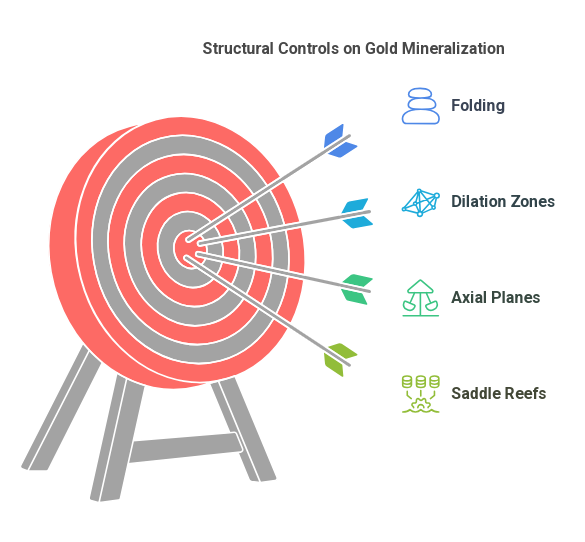
3. Quartz Veins
- Pathways for Mineralization:
- Quartz veins are common hosts for gold, forming as mineralizing fluids precipitate silica.
- Characteristics:
- Varied Morphologies:
- Can be simple, planar structures or complex, stockwork networks.
- Their shape and orientation—often lenticular—directly influence gold distribution.
- Sulfide Associations:
- Veins frequently contain pyrite, arsenopyrite, or chalcopyrite, either hosting or indicating gold.
- Fact Check:
- Research confirms that quartz veins are one of the most reliable indicators of gold potential in greenstone terrains.
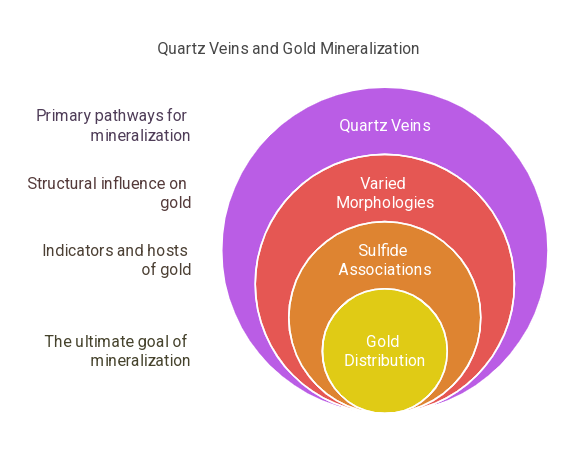
4. Faults and Fractures
- Critical Fluid Pathways:
- Faults create permeable zones that enhance hydrothermal fluid migration.
- They often intersect with shear zones, providing additional avenues for mineralizing fluids.
- Structural Integration:
- Fractures and minor faults contribute to a complex network that can localize ore, even in the absence of large-scale deformation.
- Alternate Insights:
- Some studies argue that fault reactivation can either enhance or disrupt ore continuity, emphasizing the need for detailed structural mapping.
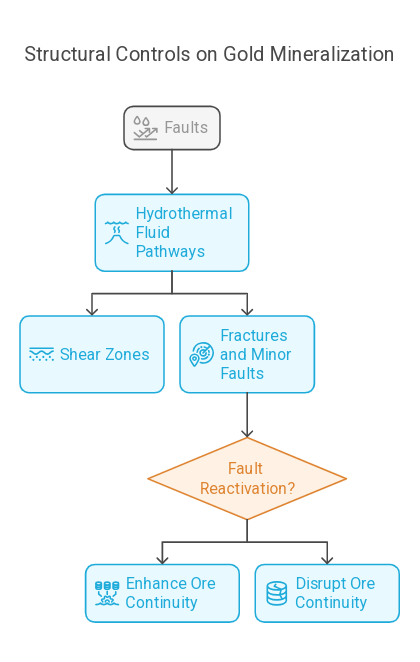
5. Lithological Contacts
- Zones of Weakness:
- Contacts between contrasting rock types (e.g., between greenstones and granitoids) act as natural fluid conduits.
- Ore Localization:
- Many gold deposits are concentrated along these contacts where chemical and physical contrasts favor fluid flow.
- Interdisciplinary View:
- While structural controls are paramount, the role of lithological boundaries is increasingly recognized as equally critical for predicting ore deposits.

6. Specific Structural Settings
- Dilation Zones:
- Areas such as fault jogs, duplexes, and releasing bends create extensional environments ideal for fluid accumulation.
- Complex Fold Geometries:
- Z-shaped or S-shaped folds provide additional structural traps that concentrate gold.
- Steeply Dipping Structures:
- Steep shear zones and faults often coincide with high-grade ore shoots, following the plunge of lineations.
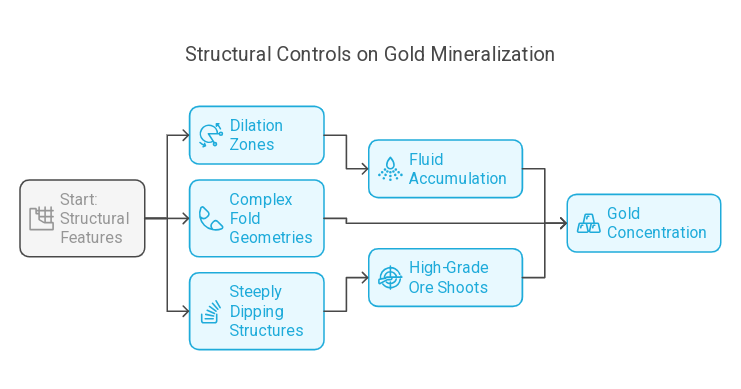
In Summary
Gold mineralization in Zimbabwe results from the dynamic interplay of multiple structural elements:
- Shear zones channel and deposit gold-rich fluids.
- Folds create dilation zones, with hinge areas often forming saddle reefs.
- Quartz veins record the passage of mineralizing fluids, frequently enriched with sulfide minerals.
- Faults and lithological contacts further refine these processes, acting as both pathways and traps.
- Intersections and specific structural settings such as releasing bends or duplexes enhance ore concentration.
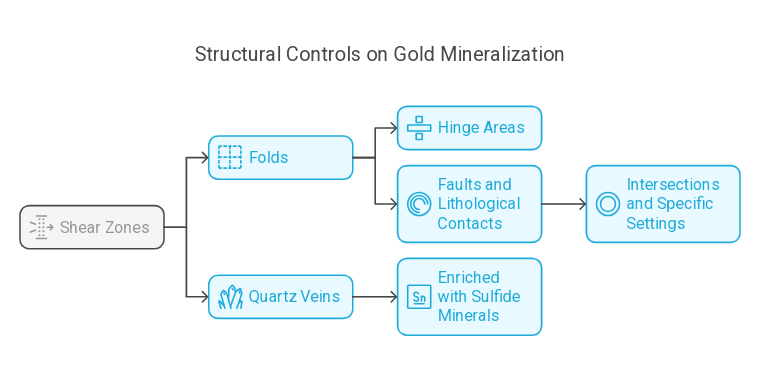
Alternate interpretations emphasize the importance of both structural and lithological factors, and modern research increasingly integrates geochemical data with structural mapping to refine exploration models. This comprehensive framework is critical for developing effective, predictive exploration strategies in Zimbabwe’s gold-bearing terrains.
References:
(Geological and structural data on Zimbabwe)
(Regional studies on fault, fold, and shear zone interactions)


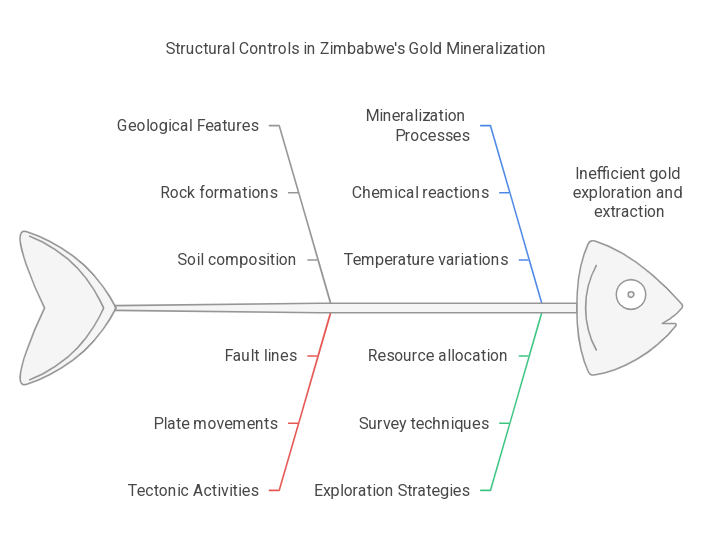
Comments ()